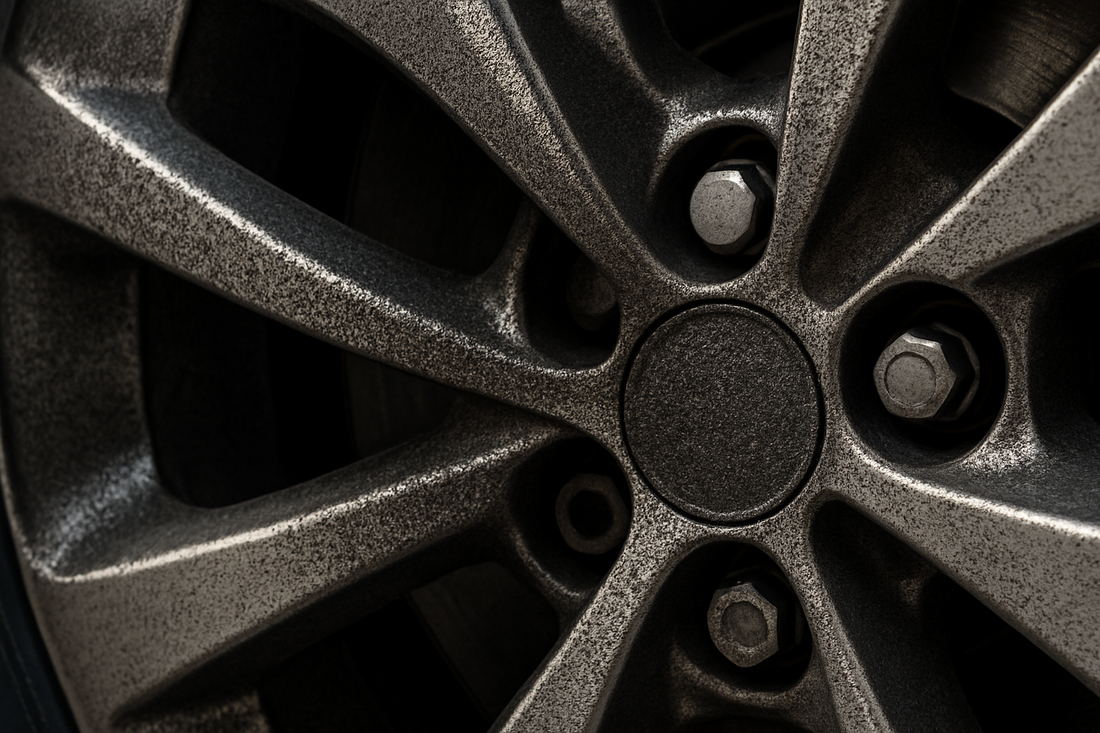
What Brake Dust Actually Does to Your Wheels (and Why You Shouldn't Ignore It)
Share
"Why clean the back of the spokes? No one sees them."
Sure, they might not see them… but your wheels definitely feel it.
Because brake dust isn't just dirt. It's metal. And when left sitting, it slowly eats away at your wheel finish — and even your car's paint — from the inside out.
So, what is brake dust really?
Every time you hit the brakes, your pads and rotors grind against each other. That friction releases tiny, hot metal particles — mostly iron and carbon — that cling to the nearest surface.
Most of it lands on your wheels. But a surprising amount floats and settles onto nearby panels, especially lower doors, bumpers, and rear sections.
Those particles then bond to the paint and clear coat, forming what's known as "industrial fallout." Over time, they start to corrode — creating that rough, gritty texture you feel when you run your hand over the paint.
The hidden damage
When moisture or humidity hits (hello, Queensland summers), the iron in brake dust oxidises. On wheels, this causes pitting and dull finishes. On paint, it can create tiny rust-like specks that eat into the clear coat if left untreated.
You'll see it first as brown flecks on lighter-coloured cars or a loss of gloss on darker ones. But even if you can't see it — it's there, bonded to the surface.
That's why pros don't just clean — they decontaminate.
The spots most people miss
- The backs of spokes and wheel barrels, where heat and dust build up.
- Lower panels behind wheels that collect airborne fallout.
- The rear of the car, where swirling airflow dumps brake dust and road grime.
These areas are easy to overlook, but they're where long-term damage begins.
How to stop the damage before it starts
Detailers know the trick: don't wait until it's visible.
Regular wheel cleaning and paint decontamination remove iron before it bonds — and keep your finish protected longer.
Here's the pro routine:
- Use an iron remover to dissolve embedded metal particles safely (on wheels and paint).
- Agitate wheels properly — including back of spokes and in between tight spokes — with a soft tool like 🦊 Fox Tail.
- Rinse thoroughly and dry to prevent mineral spotting.
- Protect with a sealant, wax, or ceramic coating to make future cleaning easier.
Bottom line:
Brake dust doesn't stay where it lands.
It spreads, bonds, and quietly damages your finish from the ground up.
So yes, cleaning the backs of your spokes matters — but so does keeping your paint decontaminated.
Not just for looks. For longevity.
🦊 Fox Tail was made for this job — reaching where others don't. Because a real detailer knows: clean wheels are just the start of a clean car.
Frequently Asked Questions
How often should I clean brake dust off my wheels?
For most drivers, cleaning brake dust every 2-3 weeks prevents permanent bonding. If you drive frequently in stop-and-go traffic or live in humid areas like Queensland, weekly cleaning is recommended.
Can brake dust damage my car's paint?
Yes, brake dust contains iron particles that can embed in your paint and clear coat. When exposed to moisture, these particles oxidise and can cause permanent rust spots and surface damage if not removed.
What's the difference between regular car wash and brake dust removal?
Regular car wash removes surface dirt, but brake dust requires iron removers and proper agitation to dissolve bonded metal particles. Standard soap and water won't remove embedded brake dust.
Is it safe to use iron remover on all wheel types?
Most iron removers are safe for painted, powder-coated, and clear-coated wheels. However, always test on a small area first and avoid using on raw aluminium or chrome wheels without checking manufacturer recommendations.
Why do the backs of wheel spokes need cleaning?
The backs of spokes and wheel barrels collect the most brake dust due to heat and airflow patterns. This hidden buildup causes the most damage over time and is where corrosion typically starts.
How can I tell if my car has iron contamination?
Run your hand over the paint after washing - if it feels rough or gritty, you likely have iron contamination. You might also see brown spots on light-coloured cars or notice a loss of gloss on darker vehicles.
